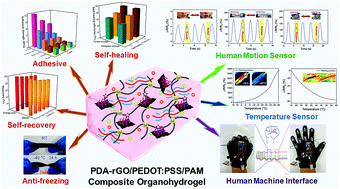Ultrastretchable, self-healable and adhesive composite organohydrogels with a fast response for human–machine interface applications†
Abstract
Hydrogel based flexible sensors have been considered as promising wearable devices in human–machine interactions, which are of great significance in mobile communications, personal healthcare, and intelligent robots. To meet the requirements of practical applications especially in harsh environments, a multifunctional strain sensor was designed and fabricated based on the polydopamine–reduced oxide graphene/poly(3,4-ethylenedioxythiophene):poly(4-styrene sulfonate) (PEDOT:PSS)/polyacrylamide composite organohydrogel (PCOH) using ethylene glycol (Eg)–H2O binary solvent as the replacement medium, which displayed an excellent anti-freezing property (−40 °C for 24 h) owing to the low freezing point of the Eg in the PCOH, high self-healing efficiency (92% tensile strength and 90% elongation at break), excellent stretchability (1350%), high sensitivity (a gauge factor of 3.19 with the strain ranging from 0 to 500%), fast response time (90 ms), long durability (800 cycles), and a wide temperature detection range (−40 °C to 60 °C), respectively. When used as a strain sensor, it was able to detect various human motions such as finger, wrist, and knee movements, and facial micro-expressions. Moreover, we also attached the flexible sensor to the yoga equipment or a neck brace for practical applications, and it could also detect the movements of the human body. Specifically, as a wearable human–machine interface device, a smart glove that takes advantage of the excellent properties of the PCOH was developed for hand gesture recognition via transmitting data to a smart phone with a real-time display via a bluetooth wireless system. Thus, these multifunctional PCOH based strain sensors have broad application prospects in human–machine interactions, sports training, and personal healthcare.



 Please wait while we load your content...
Please wait while we load your content...